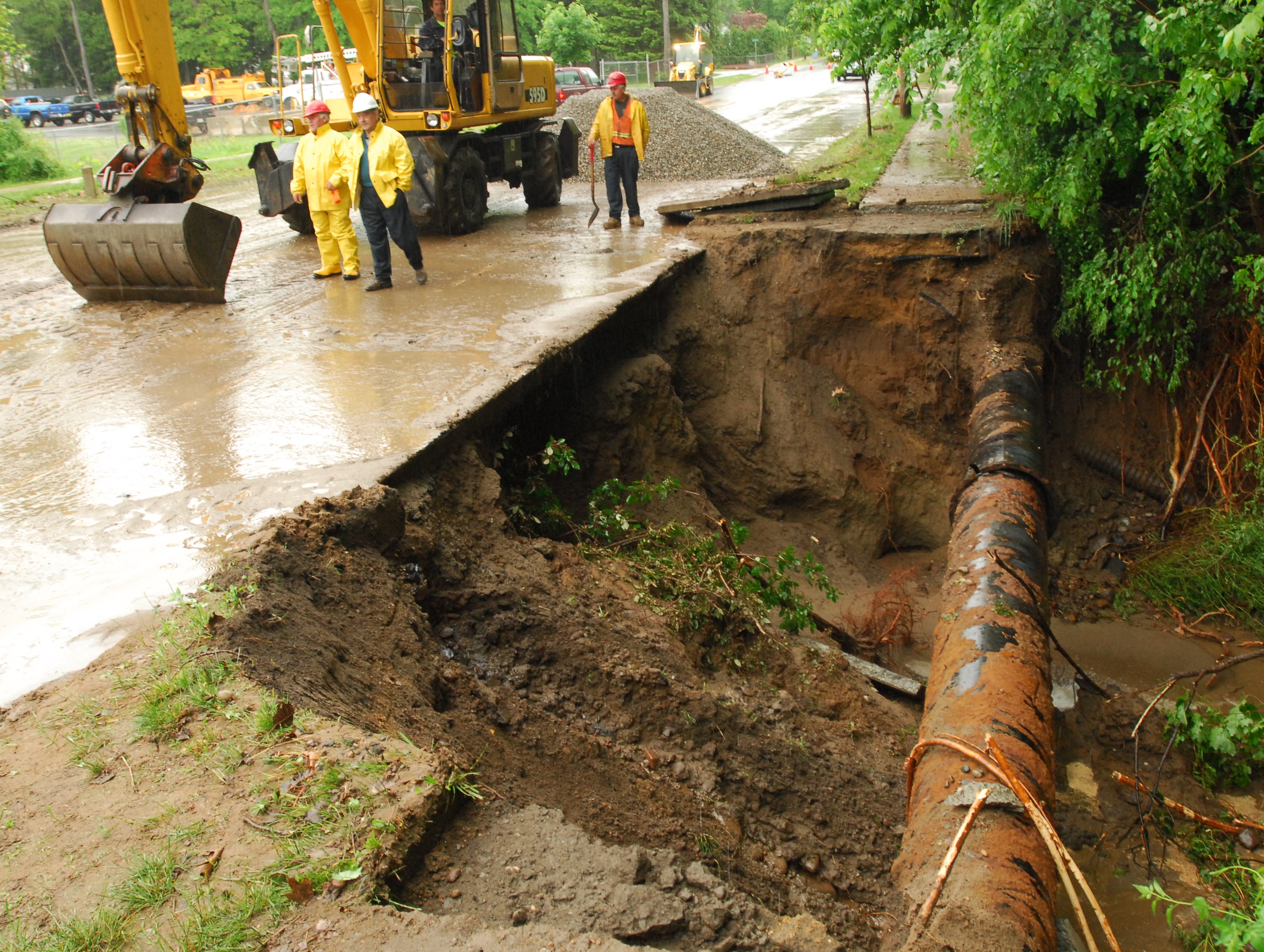Minneapolis Drinking Water Reports and Guide

Minneapolis Water Disinfection and Treatment
Because the Mississippi is a relatively dirty water source, Chlorine and Ammonia, which form Chloramines are added for disinfection. These give Minneapolis drinking water an occasional “swimming pool taste”.
The Mississippi River naturally contains moderate levels of Hard Water Minerals and Iron. Ferric Chloride is added to help reduce the brown/yellow color of the source water. A chemical softening process is also used to reduce water hardness from 14 grains down to 5-6 grains. Lastly a poly/ortho phosphate is added to help reduce the corrosive effects of the disinfectants.

Minneapolis Water Main Breaks
Minneapolis has the largest distribution system in the Midwest. There are roughly 1,000 miles of unlined cast iron pipe.
In January 2013, a massive Minneapolis water main break flooded several city blocks. The 36″ water main dumped out over 14 million gallons of water Minerals like Iron and sediment build up in old pipes throughout the city.
This causes water discoloration and requires periodic flushing to prevent “Minneapolis Muddy Waters”. Minneapolis is now upgrading 10 miles of pipe each year to overcome this discoloration (Making it a 100 year project).
Need the Right Water Treatment for Your Home in Minneapolis, MN?
Contact us for a FREE water test and site inspection. We’ll get you a FREE quote to help you get the water quality you want.
Minneapolis Water Reports
The City of Minneapolis does regular water testing and publishes the results in Annual Drinking Water Reports. These reports explain which water contaminants, and what levels have been found.
2018 Minneapolis Water Report
2017 Minneapolis Water Report
2016 Minneapolis Water Report
2015 Minneapolis Water Report
2014 Minneapolis Water Report
2013 Minneapolis Water Report
2012 Minneapolis Water Report
2011 Minneapolis Water Report
2010 Minneapolis Water Report
2010 Minneapolis Addendum
2009 Minneapolis Water Report
2008 Minneapolis Water Report
2007 Minneapolis Water Report
2006 Minneapolis Water Report
MCL: Maximum Contaminant Level
The legal limit for a certain contaminant
MCLG: Maximum Contaminant Level GOAL
The level with ZERO HEALTH RISKS, aka the “Health Limit”
All water contaminants meet the EPA’s “Legal Limit”. Contaminants that exceed the EPA’s Health Limit have been highlighted below.
Inorganic Contaminants
Inorganic contaminants include natural and manmade salts and metals. You are mostly exposed to inorganics through drinking water, most do not easily pass through skin. Carbon Filters (refrigerator and faucet filters) have almost ZERO impact on these contaminants. Reverse Osmosis very effective at removing inorganic contaminants.
| Contaminant | Amount Found | Health Limit | Legal Limit | Potential Effects |
|---|---|---|---|---|
| Cyanogen Chloride | 1.91-5.33 | 50 | NA | toxic gas that was used as a poison; it is also utilized by the chemical industry and in mining and metalworking. |
| Fluoride | 0.98-3.77 | 4 | 4 | Bone disease;children may get mottled teeth |
| Nitrate | 0.4-2.2 | 10 | 10 | Blue-baby syndrome |
Organic Contaminants
Organic contaminants can come from either natural sources like algae, or man-made chemicals. You can be exposed through drinking water, absorption through skin (bathing), and inhalation. This makes a Hybrid Filter System, or Whole House Carbon Filter a good preventative tool.
| Contaminant | Amount Found | Health Limit | Legal Limit | Potential Effects |
|---|---|---|---|---|
| Atrazine | 0.15-0.30 | 3 | 3 | Cardiovascular or reproductive problems |
| Carbon Tetrachloride | 0.7 | 0.6 | 5 | Liver problems; increased risk of cancer |
| Tetrachloroethylene | 0.06-0.6 | 0 | 5 | Liver problems; increased risk of cancer |
| Total Organic Carbon | 3.1-6.0 | NA | NA | High levels of TOC increase disinfection byproducts |
Disinfectants and Disinfection Byproducts
Disinfectants are added to kill bacteria. Disinfectants like Chlorine react with other chemicals and create “Disinfection Byproducts. These chemicals enter the body through inhalation, absorption through skin, and drinking water. A Whole House Carbon Filter is a good preventative tool in addition to a Drinking Water System for these compounds.
| Contaminant | Amount Found | Health Limit | Legal Limit | Potential Effects |
|---|---|---|---|---|
| Chlorine | 3.0-4.1 | 4 | 4 | Eye/nose irritation; stomach discomfort |
| Chloroform | 25.29-62.0 | 5.7 | 80 | Nervous system depression, increase in kidney and liver tumors |
| Haloacetic Acids | 10.2-55.5 | 0 | 80 | Increased risk of cancer |
| Total Trihalomethanes | 14.9-80 | 0 | 60 | Increased risk of cancer |
Microbial Contaminants
Microbes like bacteria and virus come from a variety of sources. These include water main breaks, leaky septic systems, livestock, and wildlife. Microbial contaminants are mainly consumed through drinking water. Carbon Filters and Water Softeners do not offer any protection against microbes, but UV Treatment is very effective.
| Contaminant | Amount Found | Health Limit | Legal Limit | Potential Effects |
|---|---|---|---|---|
| Cryptosporidium | 5-119*** | 0 | 115(oocysts/100L) | Short-term exposure: Gastrointestinal illness (diarrhea, vomiting, cramps) |
| Giardia | 7.0-435*** | 0 | 149(cysts/100L) | Short-term exposure: Gastrointestinal illness (diarrhea, vomiting, cramps) |
| Mammalian Virus | 1.0-37.0*** | 0 | 9.5(MPNX/100L) | Short-term exposure: Gastrointestinal illness (diarrhea, vomiting, cramps) |
| Total coliform bacteria | 1%**** | 0 | 5% | Not a health threat itself; it is used to indicate whether other potentially harmful bacteria may be present |
| Turbidity | 0.28-0.56 | NA | NA | Turbidity measures water cloudiness. It is used to indicate water treatment effectiveness (e.g., whether disease-causing organisms are present). Higher turbidity levels are often associated with higher levels of disease-causing microorganisms such as viruses, parasites and some bacteria. These organisms can cause short term symptoms such as nausea, cramps, diarrhea, and associated headaches. |
*Upon re-testing, 0% Coliform Bacteria was detected.
Radionuclide Contaminants
Radionuclides in water may occur naturally, or come from oil and gas production or mining activities. These can be inhaled, or consumed through drinking water.
| Contaminant | Amount Found | Health Limit | Legal Limit | Potential Effects |
|---|---|---|---|---|
| Alpha Emitter | 0.4 | 0 | 15.4 | Increased risk of cancer |
